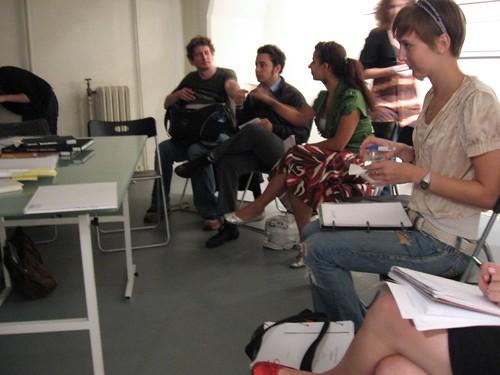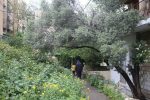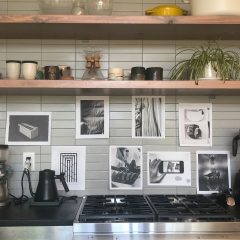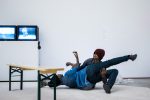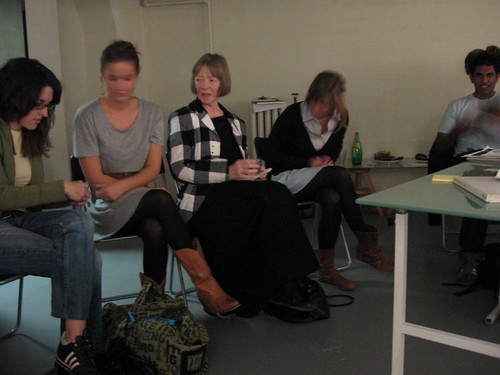
Hofer between her assistants Victoria Lelandais Gandit (grey top to left of Hofer) and Alex Janta (on the right of Hofer, with black sweater), taken at Slought Foundation. Christine McMonagle is on the far left.
Candida Hofer, the internationally known German artist acclaimed for her enormous photographs of architectural spaces, is here in Philadelphia until the 27th. What she’s doing here, how her visit came about and what she had to say to a class of art history students at the University of Pennsylvania are what this post is about.
Why she’s here
Hofer is in town for 10 days to photograph a number of architectural spaces in Philadelphia–a miracle of sorts given the trouble she has had until now, and especially post 9/11, photographing U.S. architecture. Yet here she is with access, insurance, and permits, in the most cautious and litigious of cities.

Candida Hofer, Théâtre royal de la Monnaie/Koninklijke Muntschouwburg, 2006, C-print, 78.7 x w: 100.4 in., Patrick De Brock Gallery
The buildings she is photographing are City Hall, the Masonic Temple, several spaces at Girard College, Frank Lloyd Wright’s Temple Beth Sholom in Elkins Park, the Frank Furness art history library at Penn, PAFA’s old historic building, Eastern State Penitentiary and the Academy of Music.
How Hofer came to be here
How she came to be here and get access to all these buildings in Philadelphia has to do with Mari Shaw. Roberta and I first met Mari at the Art Museum, where one of her Isa Genzken sculptures was on loan. It turns out Mari is not only a major collector of contemporary art, but she loves to make things happen.
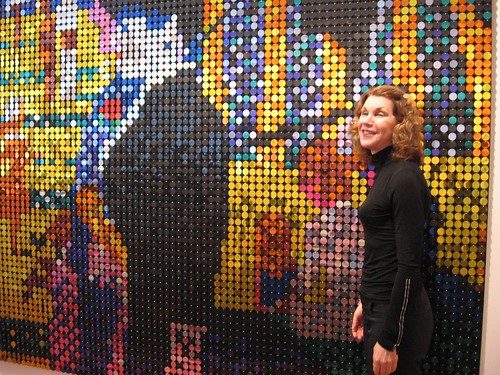
Shaw owns not only some photographs by Hilla and Bernd Becher, Hofer’s mentors, but Shaw’s children own Hofer’s giant photographs of the Louvre. Shaw was visiting her friend Alexandra Pinho another major collector of contemporary art, who also established the Banco de’Espirito’s “very significant contemporary art collection.” Oh, yeah, and she’s the wife of the Portuguese Minister of the Economy. Pinho, like Shaw, loves to make things happen.
Hofer was in Portugal at the time, photographing Portuguese buildings at the invitation of the Pinhos, who wanted to project an image of Portugal and its beautiful buildings and its past through contemporary art.
Shaw thought it was a great idea. She met with Hofer in Berlin. “So I talked to Candida about doing something in Philadelphia and how Philadelphia was our first [capital] city and had the most interesting old buildings. …I assured her that Philadelphia would welcome her with open arms, and I would arrange [access] for her. I did not understand how time consuming that was. …I had to jump through a number of hoops.”
The hoops included signing contracts, negotiating to get charges waived and giving the copyright for reproduction rights to Hofer. She also had to arrange for insurance–done through Slought Foundation. “Hofer had never before needed insurance!” said Shaw. Only in the United States!!! Shaw made arrangements through Slought Foundation’s insurance. There were so many details, she hired an assistant, local art photographer–and Hofer fan–Christine McMonagle, to help. “She’s thrilled to be involved.”
Shaw figured out which buildings might interest Hofer. McMonagle took some preliminary photographs to help Hofer pick. “Candida in the past photographed mostly baroque buildings. I planned a variety of very different spaces and textures for her to photograph.”
“This has been 18 months in the making.”
The discussion
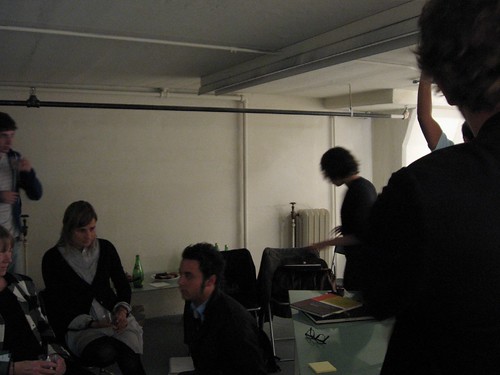
The room at Slought is like a cellar, the antithesis of the soaring spaces that fill so many of Hofer’s photographs.
Slought Foundation and Penn are part of Shaw’s network; she teaches at Penn as does Aaron Levy, who’s executive director of Slought. That’s how Hofer came to speak to Levy’s art history class.
The class assembled in a circle in the vault at Slought yesterday, a low-ceilinged room that feels like a cellar. Also joining the discussion were Shaw, three MFA students from the Pennsylvania Academy of the Fine Arts, and Roberta and me. Then Hofer arrived with her two assisants–two young French women, Victoria and Alex, both sporting boots–and with McMonagle, who has the privilege of also working with the photo shoots. It made a grand total of 19 people in the small, windowless room.
I couldn’t help but laugh at the contrast between Hofer’s oeuvre of carefully lit, enormous spaces and the looming dimness of the crawl space we were occupying.
Hofer herself wore a giant-checked white and black jacket the only light spots in an otherwise all black outfit. Her hair–bangs straight across and a bob–accented her seriousness. I asked if I could take some photographs of her and she looked trapped for a moment, but then agreed.
Shaw told the story of how Hofer came to be here. When Hofer photographed City Hall, Shaw said, “I’ve never seen the people in City Hall so proud of anything,” a contrast to Philadelphia’s usual self-hating attytood.
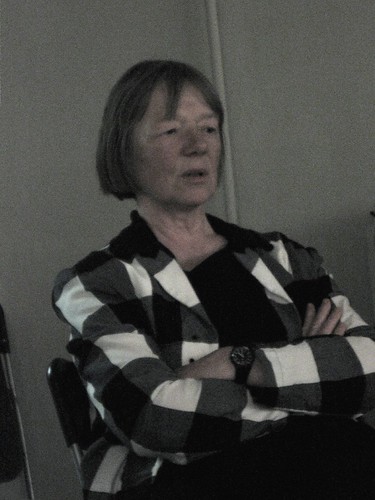
Hofer in a closeup. (I don’t know why I bother taking my camera’s version of telephoto pictures. They are terrible. Hope springs eternal.)
Here are some highlights from Hofer’s answers to the groups’ questions:
She finds her subjects in books and the internet. And once she decides she is interested in a building, she doesn’t change her mind, at least so far.
When she takes a picture, she doesn’t necessarily take in all the details. But when she creates the big prints, “I’m more in the space than when I take the photograph.” She later said, “I don’t remember how the space looks when I do the prints. I also do them lighter than they [really] are, so they look fresher, lighter.” .
When she began, the photographs were smaller, but she said they are more real because they are bigger.
She does not see her photographs as being part of a series, but rather as individual pieces. “It doesn’t matter if I take the picture in Dublin or in Philadelphia,” she said.
She was a little opaque about why she chose what she did. “I do what I want; I do what I like.”
She shot down any idea of her pictures as a kind of cultural anthropology. “I don’t have this feeling.”
When Hofer enters a space to photograph it, her decisions are quick. “When I enter a room, I know quite soon what will be the best.” One of the assistants added that Hofer’s choices of what to shoot were intuitive. Then Hofer graciously added, “Victoria and Alex, immediately they understood what I want, what I need.” She also added that her other assistant,Ralph (not present at the talk), did the technical part and that Christine, Mari’s assistant, was helping “to arrange, bring things out.”
Hofer uses a big format camera and she works with both analog and digital. “We are getting more and more technical,” she said. She is impressed by the quality the digital cameras can give her. She and her crew immediately look at a digital picture on a lap top screen for instant feedback.
In Philadelphia, they are working with digital, partly because going through security is a problem for the film. “Sometimes it’s better analog, sometimes it’s better digital,” she said. “Don’t ask me why,” she said with a laugh.
Hofer has the same issues that all photographers who work with analog methods have–the disappearance of the film and the color photo labs. “I work with Kodak material…tungsten.” With its disappearance from the market, she has taken steps. “Last year I bought three big freezers, and every freezer is full with [analog] material.”
Hofer does crop her images.
McMonagle, who is accompanying the crew on the shoots, said it’s a great experience for herself, because it’s seeing familiar buildings anew, “looking at things I don’t normally think about.” Hofer added that it was quite the same for her, as when she visits the Louvre or the Hall of Mirrors at Versailles or Weimar. When it’s empty for her photography, “it looks different.”
“After you take a photograph, do you see [the space] differently?” Shaw wondered.
“Yes. I feel privileged that I can see it in another situation.”
Levy suggested that her works “map an idea with order.” With people, the spaces are disordered, he said. But she said that some of her photos from the past have people in them. And when a student suggested that the absence of people suggests the presence of people, Hofer was not so interested in that idea.
Besides talking about a number of buildings and projects she has photographed–from, most recently, the local Frank Lloyd Wright synagogue to the Yale Beineke rare books libary to a project to photograph the 12 casts of the Burghers of Calais. The Rodin project had previously brought her to Philadelphia. The project, about the 12 casts in 12 milieus, started her talking about how she likes to see her own work interacts with different exhibition spaces.

Candida Höfer, Biblioteca do Palacio Nacional da Ajuda Lisboa I, 2006, 66.9 x w: 59.8 in, C Print; this is one of the Portugal photographs at Sonnabend Gallery.
One of the students asked, “Do you have all your work from forever?”
“I hope so,” Hofer said. “I’m a photographer; I have to take care of my negatives.” She has an assistant to takes care of her archives and all the maintenance of her work. And the color photo lab she uses, which is in Dusseldorf, is very close to her studio/archive space. Her relationship with her lab–which she does not own, she specified–is there’s a technician there who she always works with. “The lab gives us a lot of space to work. We always work with the same technician. I can give them a phone call and they take care of it.”
Levy wondered if she was frustrated at being always identified as one of the Bechers’ many proteges, at least in English language books.
“Not for me, but for some of my colleagues,” she said. “I was one of the first of the students of the Bechers.” And through them, she came to show in the Konrad Fischer Gallerie.
She said history had nothing to do with her work, and she objected to a catalog essay from the Architecture of Absence show (that traveled her to the Institute of Contemporary Art) that suggested there was something significant about her having been born post WWII. “This was new to me,” she said of the concept. The curator “had the idea that this would be an influence on my work! And then because it was in one book, someone repeated it in other books.”
I asked if she would describe herself as a fan of architecture. She broke out in a big smile. “I am a fan.”
The timing on Hofer’s visit here coincides with her exhibit of the Portugal photos at Sonnabend Gallery, which Roberta will write about some time next week. She also will be writing about Shaw, the woman behind all of this–and lots more. Stay tuned.


